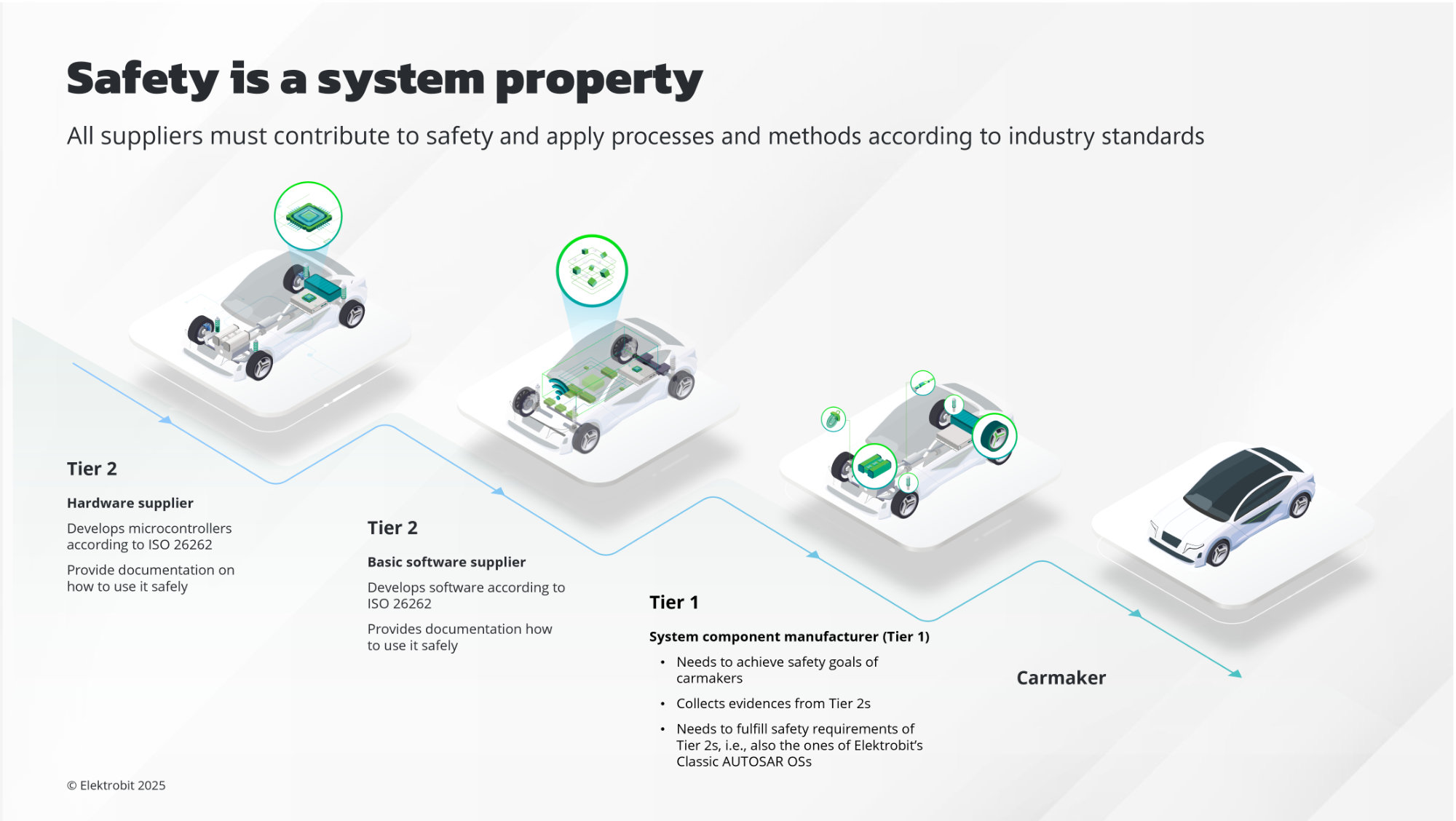
The moment happens fast. You’re driving down the highway, a car swerves into you unexpectedly, and in a split second, your airbag deploys flawlessly. What you don’t see is the chain of software decisions happening behind the scenes: sensors firing, data interpreted, commands executed. But what if just one of those systems failed?
For developers of automotive software, that “what if” is never theoretical. Safety isn’t just a requirement, it’s a responsibility. And ensuring reliable performance, especially in safety-critical systems up to ASIL-D, means navigating a complex landscape of standards, suppliers, and system-level dependencies.
In today’s vehicles, safety is more than a feature, it is a foundational requirement. Consider the airbag. A split-second deployment decision can save a life. That decision is made not by a person, but by software. If that software fails, the airbag may deploy at the wrong moment or not at all. This is why software safety matters, and why Elektrobit is focused on helping the automotive industry get it right.
In a recent webinar, Elektrobit explored how to achieve seamless integration of safety operating systems up to the highest safety integrity levels, ASIL-D (Automotive Safety Integrity Level) and SIL 3 (Safety Integrity Level), without the complexity that often plagues development teams. Here’s the story behind the story – and why it matters.
Safety is a system responsibility
Automotive safety doesn’t rest on the shoulders of a single team. Carmakers, Tier 1 suppliers, and Tier 2 software and hardware vendors all play a part. Each must contribute safe components, follow rigorous processes, and provide clear documentation. ISO 26262 provides the roadmap, demanding safety from the ground up, with levels from ASIL-A to ASIL-D.
or Tier 2 software providers like Elektrobit, that means more than building quality software. It means proving that quality, enabling their customers to build safe systems, and ensuring that safety can scale across programs.
A Foundation for confidence: EB tresos Safety OS
At the core of Elektrobit’s approach is EB tresos Safety OS, a Classic AUTOSAR-based operating system built for ASIL-D applications. It comes safety-certified and is part of a comprehensive suite that supports everything from quality-managed (QM) components to full ASIL-D safety-critical systems.
Elektrobit also offers EB tresos AutoCore OS as a safety-ready solution for projects up to ASIL-B. Whether safety-certified or safety-ready, the company provides the necessary manuals, guides, and evidence to help customers build their own safety cases.
No surprises, no delays
Elektrobit understands how frustrating it is to get hit with hidden costs or to stall while waiting for external verification services. That’s why the company delivers transparency from day one. For ASIL-B projects, customers can follow a straightforward application guide. For ASIL-D, Elektrobit supplies a safety-certified OS out of context, along with a safety manual that explains how to use it correctly. There are no mandatory service contracts. No salami slicing. Just clear guidance and reliable tools.
Freedom From Interference, by design
Safety isn’t just about what the software does. It’s also about what it doesn’t interfere with. Elektrobit’s architecture supports memory protection that allows safe coexistence of Quality Managed (QM) applications and safety-critical components on the same ECU. This allows developers to isolate risks, argue for freedom from interference (FFI), and optimize CPU usage without compromising safety goals.
Whether using safety-certified components like EB tresos Safety TimE and E2E, or safety-ready components like AutoCore OS, customers have the flexibility to build the architecture that best suits their needs. Elektrobit supplies the documentation, quality reports, and safety guides to help teams prove correctness at every level.
The customer wins
This modular, transparent approach puts control back in the hands of the customer. ASIL-B teams can move forward independently. ASIL-D teams can integrate Elektrobit’s safety-certified software as a Safety Element out of Context, reducing both risk and effort.
And all customers get the same benefit: confidence! Confidence that their operating systems are safe. Confidence that their integration path is clear. Confidence that their supplier has done the heavy lifting so they can focus on innovation.
Mastering Classic AUTOSAR safety requirements is no small feat, but with the right approach, you can deliver on time and meet every standard. For a deeper dive and to read more on this topic, check out these webinars:
- Turning safety challenges into the path to autonomous safety
- Seamless Integration of Safety Operating Systems up to ASIL D/SIL 3
In safety-critical systems, better safe is always better. Elektrobit makes it easier to get there.





